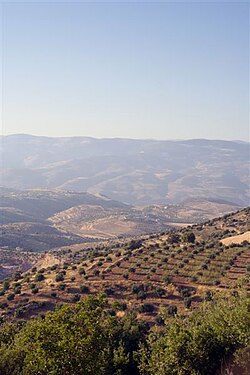Gileadite
Etymology
Gilead is explained in the Hebrew Bible as derived from the Hebrew words גלעד gal‛êd, which in turn comes from gal ('heap, mound, hill') and ‛êd ('witness, testimony'). If that is the case, Gilead means 'heap [of stones] of testimony'. There is also an alternative theory that it means 'rocky region'.
From its mountainous character, it is called the Mount of Gilead (Genesis 31:25; Song 4:1). It is called also the Land of Gilead (Numbers 32:1, Judges 10:4) in many translations, and sometimes simply Gilead (Genesis 37:25; Judges 10:8; Psalm 60:7), also mentioned in Micah 7:14–15.
History
Hebrew Bible
The name Gilead first appears in the biblical account of the last meeting of Jacob and Laban (Genesis 31:21–22). In Book of Genesis, Gilead was also referred to by the Aramaic name Yegar-Sahadutha, which carries the same meaning as the Hebrew Gilead, namely "heap [of stones] of testimony" (Genesis 31:47–48).
According to the biblical narrative, during the Exodus, "half Gilead" was possessed by Sihon, and the other half, separated from it by the river Jabbok, by Og, king of Bashan. After the two kings were defeated, the region of Gilead was allotted by Moses to the tribes of Gad, Reuben, and the eastern half of Manasseh (Deuteronomy 3:13; Numbers 32:40).
In the Book of Judges, the thirty sons of the biblical judge Jair controlled the thirty towns of Gilead (Judges 10:4), and in the First Book of Chronicles, Segub controlled twenty-three towns in Gilead (1 Chronicles 2:21–22). It was bounded on the north by Bashan, and on the south by Moab and Ammon (Genesis 31:21; Deuteronomy 3:12–17).

"Gilead" mentioned in the Book of Hosea may refer to the cities of Ramoth-Gilead, Jabesh-Gilead, or the whole Gilead region; "Gilead is a city of those who work iniquity; it is stained with blood" (Hosea 6:8).
The kingdoms Ammon and Moab sometimes expanded to include southern Gilead. King David fled to Mahanaim in Gilead during the rebellion of Absalom. Gilead is later mentioned as the homeplace of the prophet Elijah.

Neo-Assyrian province
King Tiglath-Pileser III of Assyria established the province of Gal'azu (Gilead) c. 733 BCE.
Arabic
Gilead (Arabic: جلعاد, Ǧalʻād or Jalaad) is an Arabic term used to refer to the mountainous land extending north and south of Jabbok. It was used more generally for the entire region east of the Jordan River. It corresponds today to the northwestern part of the Kingdom of Jordan. The region appears in the ancient Safaitic inscriptions.
See also
- Balm of Gilead
- Machir
- Machir (tribal group)
- Shibboleth
- Tribe of Manasseh
- Perea
- Balqa
- Republic of Gilead
References
- ^ Jones, Daniel (2011). Roach, Peter; Setter, Jane; Esling, John (eds.). Cambridge English Pronouncing Dictionary (18th ed.). Cambridge University Press. ISBN 978-0-521-15255-6.
- ^ Wells, John C. (2008). Longman Pronunciation Dictionary (3rd ed.). Longman. ISBN 978-1-4058-8118-0.
- ^ Easton's Bible Dictionary, Galeed
- ^ "Gilead | ancient region, Palestine | Britannica". www.britannica.com. Retrieved 2021-12-09.
- ^ Hebrew Dictionary, Strong's Concordance of the Bible, reference #5707
- ^ Smith's Bible Dictionary, "Gil'e-ad"
- ^ Bible Atlas, Jegar-sahadutha (Ramoth-gilead).
- ^ "Gilead | ancient region, Palestine | Britannica".
- ^ "OCIANA - Online Corpus of the Inscriptions of Ancient North Arabia".